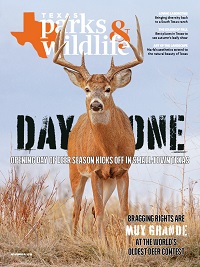
Flora Fact: What's in a Name?
The rare rough-stemmed aster has had an identity crisis.
By Anna Strong
Rare flowers can be hard to find, especially if they've had more name changes than a guy in the witness protection program. Persistence pays off with the rare rough-stemmed aster.
Look along Northeast Texas highway rights-of-way from September to November to find this beauty. To distinguish it from the other half-dozen more common blue- or purple-flowered asters in the area, three characteristics must be present. Rough-stemmed aster is the only blue/purple-flowered aster in Northeast Texas with stiff, long hairs on the midstem, clasping midstem leaves with rounded bases and recurved phyllaries (green, leaf-like structures under the flower head).
The habitat of this rare aster includes relatively open sites of natural wetlands — seeps, bogs and springheads, for example — and degraded wetlands. But, like Goldilocks, the rough-stemmed aster needs habitat that is “just right.” It doesn’t like areas that are too wet or too dry, and so it prefers edges of wetlands. But because of its affinity to saturated soils, the plant is threatened by ditching and draining of wetlands. Conversely, damming ponds to create lakes decreases the available habitat for this rare plant. The rough-stemmed aster also can be negatively affected by mowing to the edge of drainages.

Not only is rough-stemmed aster troublesome to identify and threatened by habitat disturbance, but it is further plagued by frequent name changes. Botanists have changed the scientific name of rough-stemmed aster (now, Symphyotrichum puniceum var. scabricaule) no fewer than four times in the 70-odd years since the species was discovered. Such name changes frustrate many a naturalist. It sometimes seems that as soon as one alien-sounding name is memorized, another one is created and deemed correct.
To make matters worse, in many cases, the former scientific name (say, Aster scabricaulis) is both easier to remember and easier to spell. Most people would agree that the name Aster is more familiar and easier to pronounce than Symphyotrichum. The latter name first arose in 1832 but was never widely used.
Then in 1994, when many of the North American asters were found to be different from their European and Asian brethren, most New World asters were transferred to the genus Symphyotrichum.
Name changes are not arbitrary. The changes reflect new knowledge and techniques. With the rise of the internet, old names, new names and misspelled names now can be found.
» Like this story? If you enjoy reading articles like this, subscribe to Texas Parks & Wildlife magazine.
Related stories

